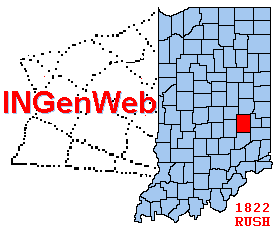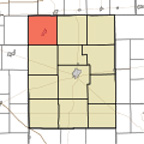

Rush County, Indiana
Genealogy
and History


Rush County, Indiana
Genealogy
and History
Centennial history of Rush County, Indiana Transcribed for the Rush Co. INGenWeb Project by Mark S. Mount
Authors: Anonymous
City of Publication: Indianapolis
Publisher: Historical Pub. Co.
Date: 1921

This townsip is situated in the northwest corner of Rush county and is bounded on the north by Henry county and two sections of Hancock county, on the east by Center township, on the south by Posey towship and on the west by Hancock county. Carthage, a town of about 900 population on the Big Four railroad, near the center of the township, is the trading center and has been so from the beginning, the Quaker settlement which sprang up on the Big Blue at that point in pioneer days having maintained its dominance as a social and commercial center. Farmers, a station on the Big Four in section 33, is a trading point in the southeast corner of the township. Ripley township is well drained, being traversed from the northeast corner to the southwest corner by Big Blue river, which gave power to the mills in pioneer days. Six Mile creek drains the western portion of the township and Three Mile creek enters Big Blue in the northeastern portion.
The first permanent settlement in the township was made by a colony of Quakers from North Carolina, who settled there in 1821. Even before the lands were opened by the Government for sale Joseph Henley, Samuel Hill and a party had come out here into the wilderness from North Carolina to "spy out the land" and had selected lands along the Big Blue in the vicinity of where Carthage later came to be laid out. At the land sale Robert Hill, son of Samuel Hill and brother-in-law of Joseph Henley, acting as agent for the colony, purchased the tract and in 1821 several families settled, including those of Thomas, Jonathan and Nathan Hill, brothers of Robert Hill; Andrew Thorp, Dayton Holloway, Benjamin Snyder, William Wilson, Pearson Lacy, Benjamin Cox and Nathan White. In the next year others came and by 1825 there was a quite numerous settlement in the rich lands of the township. The first birth of a white child in the township was in the family of Nathan Hill in 1822 and the first marriage in the township was that of William Binford and Mary Jessup. It was not long after their arrival on the scene before the colony of Friends had a log meeting house erected on Walnut Ridge and in this pioneer meeting house the first school was conducted, Nathan Hill being the teacher. Robert Hill opened the first store and this early commercial center became the nucleus around which Carthage grew up. Robert Hill, who had acted as the agent for the colony in the purchase of their lands, also was the first miller and was an active factor in the development of the community. The first blacksmith was Dayton Holloway, who some years later also started a mill. Until the coming of the Shelbyville & Knightstown railroad in 1848 the development of the community was about that of the normal rural community, but when the railroad gave Carthage a proper outlet it began to expand and has ever since been the second town in point of population in the county. Among others besides those above mention who were classed as pioneers of Ripley township were John Addison, John Walker, William James, Samuel Moore, Isaac Tullis, Henry and Thomas Henley, Reuben Bently, Nathan Pattijohn, Luke Newsom, Jonathan Pierson, Jonathan Phelps, John Dawson, Jacob Siler, John Reddick, Sarah Commons, Hannah Earnest, Thomas Draper, Henry Newby, Thomas Cogshall, Lindsey Hearkless, Elias Henley, Stephen Bentley, John Gates, Mahlon Hockett, Abraham Small, Thomas Thornburg, Joel Pusey and William Johnson.
Carthage - In point of size and business importance Carthage is second only to Rushville as a commercial center in Rush county. It is beautifully situated on the banks of Big Blue river about the center of the township and is an important shipping point on the Big Four railroad. The big plant of the American Paper Products Company at this place is regarded as one of the most extensive industiral concerns in Rush county and employs about 150 persons. Thouogh Carthage has been established as a trading point in the early '20s, as noted above, when Robert Hill opened his little store there, it was not officially recognized on the map until August 18, 1834, when John Clark and Henry Henley filed a plat of the village. This plat which was laid out in the northeast corner of the northwest quarter of section 19, township 15, range 9 east, comprised thirty-two lots, sixteen on each side of Main street, the cross streets being named First, Second and Third. Five or six additions have since been made to this original plat and the town now has a population in excess of 900 and is substantially built. Natural gas is provided by the Carthage Natural Gas Company, William Bundy, president, and light is provided by local electric light plant of which F. F. Brennan is the proprietor, he getting his power from the paper mill. The Carthage Bank and the Carthage Building and Loan Association are important commercial factors in the town, while the grain elevator operated by the Hill Grain and Coal company offers a market for the local cereal crops. Otto O. Griffin, who was commissioned in 1918, succeeding the late L. B. McCarty, is the postmaster. The township commissioned high school is one of the handsonest school buildings in this part of the state and is ample in equipment for the needs of the town's public schools. There also is a school for colored children, called the Booker T. Washington school. The considerable colored population in and about Carthage is descended from the failies brought there in the days before the Civil war by means of the "underground railroad," a station of which was maintained by the Friends in that vicinity. There are also two colored churches, one for the Methodists and one for the Christians. The other churches are those of the Friends, of which the Rev. A. J. Furstenberg is the pastor; the Fletcher Methodist Episcopal, Rev. Arthur Jean, pastor; the Wesleyan Methodist, Rev. H. T. Hawkins, pastor, and the Christian, Rev. Sumner, pastor. The very attractive Henley Memorial Library erected in 1902 is an admirable social center for the community. It was constructed by volunteer contributions of public spirited citizens. Henry Henley, one of the founders of Carthage, moved by a desire to benefit the people of that community, gave $1,000 to establish a free public library. This gift was added to by private persons, the W. C. T. U., the Carthage Monthly Meeting of Friends and by a small tax authorized by law. A board of directors was appointed, composed of W. P. Henley, J. M Stone, N. C. Binford, Levi Minford, J. F. Publow, Eunice H. Dunn and Luzena Thornburg, and an organization effected under the law. For some time a room in the Carthage Bank building was used, but the demand for more books and more room let to an effort to supply both. The children of Henry Henley gave $2,000 to the building fund, other subscriptions were made and the additional sum required was raised by taxation. As a result the present beautiful building was erected at a cost of $6,500.
The library is well maintained and is patronized by the whole township. The town is well represented abroad by its weekly newspaper, the Citizen, C. G. Hill, editor and proprietor. The Freemasons and the Odd Fellows have lodges at Carthage and there is a dwindling post of the Grand Army of the Republic and a vigorous post of the American Legion. The Auditorium theater, J. F. Tweedy, manager, offers the community a place of entertainment. Hotels are conducted by Mrs. H. G. Rolls and Mrs. Elmira Smith, while J. F. Kennedy and C. E. Rhoades have restaurants. Other business in the town is represented as follows: Grocers, Hungate Wholesale Company, A. W. Winfield, Phelps Bros., T. E. Cooper; dry goods, F. J. Sims, F. B. Yankuner; hardware, C. E. White & Son, Sharer & Moore; music and musical instruments, Gates Music Company; tailor, J. A. Lineback; drugs, O. C. McCarty; barbers, Peacock & Kyser, George F. Winslow; garages, H. T. Beher, Ralph Lindamood; blacksmiths, James Carfield, William Shaffer; feed store, R. C. Hill; shoemakers, W. A. Minor, William Snyder; bakery, T. J. Passwater; poolroom, Parish Bros.,; sawmilll, R. T. Moore; canning factory, the DeSchipper Canning Company, John DeSchipper, manager. The industries of Carthage began about the time Robert Hill put up his store there back in pioneer days, this pioneer's second enterprise being the erection of a sawmill to which plant he presently added a gristmill. The next merchants were Eli and Joseph Stratton, Hill & Henley, L. & Hill, Jabez Henley and Jason Williams. Among the early mechanics were John Sears and Isaac Nelson, blacksmiths, and George W. Pearce, wagon maker. Formerly the town supported a busy planing mill which was operated by Hiram and Jesse Henley, Theodore Moore had a sawmill, Charles Moore a cement block factory and John Dana a cannery. Cox & Cox’s flour mill was a busy institution in its day and Charles R. Butler had a machine shop.